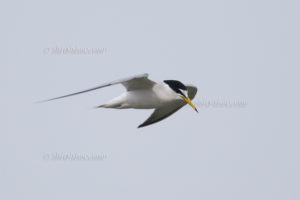 The gravel and sand pit opens up a view like over a prehistoric river landscape. Between shallow water areas, sandy areas, reeds the blue water sparkles. The edges of the pit are separated by heaped dams from the agricultural land. Suddenly a bird emerges at about the edge of the dam, which is characterized by a peculiar flight. Choppy wing movement is a feature. This is typical for the flight of the Little Tern (Sternula albifrons). The movement is easy and fast. In between, a sharp and shrill “ki-ki-kit” is heard again and again. Yes, the distinctive, penetrating calls of the Little Tern make it possible to identify and recognize them even at a distance. Sometimes the bird stops and hovers when hunting for fish at low altitude above the water surface. The Tern stands in the air until it has spotted a fish, circles into a dive, disappears with a lot of water splashes in the pebble lake, then (hopefully) catches a fish and rises again from the water under water splashes.
The gravel and sand pit opens up a view like over a prehistoric river landscape. Between shallow water areas, sandy areas, reeds the blue water sparkles. The edges of the pit are separated by heaped dams from the agricultural land. Suddenly a bird emerges at about the edge of the dam, which is characterized by a peculiar flight. Choppy wing movement is a feature. This is typical for the flight of the Little Tern (Sternula albifrons). The movement is easy and fast. In between, a sharp and shrill “ki-ki-kit” is heard again and again. Yes, the distinctive, penetrating calls of the Little Tern make it possible to identify and recognize them even at a distance. Sometimes the bird stops and hovers when hunting for fish at low altitude above the water surface. The Tern stands in the air until it has spotted a fish, circles into a dive, disappears with a lot of water splashes in the pebble lake, then (hopefully) catches a fish and rises again from the water under water splashes.
The Little Tern is a typical small tern. It is told apart from afar by its conspicuous flight, her size (if to assess) and especially the pale yellow beak with a small dark tip on. If you look closer, the white forehead (unlike the Common Tern (Sterna hirundo) will stand in front of a black head cap. Like in the other Sterna-terns, the plumage is quite light, grey on the back and wings with a white rump and a white belly. Thus, from a distance, the species can easily be confused with the Common Tern.
The Little Tern is dependent on early and relatively short-lived stages of river development with erosion, sand deposition, dune formation and free beach areas. When the succession begins, their breeding habitat disappears and the bird disappears as well as the vegetation grows. In the middle Elbe region south of Wittenberg it is a gravel pit near Mühlberg or Muehlberg (Brandenburg), which is now an ideal habitat for these birds. Around 2003, the first settlements of Common Terns were registered in the gravel pit Mühlberg. Later, some breeding pairs of the Little Tern were also reported. There was a small colony (2006 2-3 breeding pairs, increase by 2009 to 8 breeding pairs) in socialization with Common Terns. For the Little Tern, there was a further increase in 2013 to 16 breeding pairs. The colony is now protected by an elaborate electric fence to deter land raptors.
The Little Tern is often seen flying in a typical flight over shallow water, sometimes jarring. There she dives for fish. But it picks insects from aquatic vegetation or directly from the water surface as well. Also a hunting technic as like a flycatcher on small flying insects over the water has been observed.
To cope with the growing demand for top shots of the rarer species of the Palearctic Bird-Lens is keen to enrich the range of pictures of birds you can find in the western Palearctic. Trips to remote places to capture images not only of rare birds of western Palearctic were very successful. The nice image of the blog is only a first impression, what you will find in the gallery in the “Picture Shop” very soon. Just give bird-lens.com a message, if bird-lens.com could serve you with an image needed before the new pictures are online.